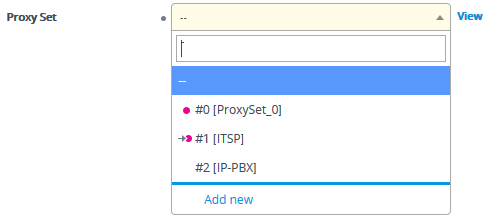Invalid Value Indications
The Web interface provides the following indications of invalid values when configuring table rows:
|
■
|
Parameters configured with invalid values: An invalid value is a value that is not permissible for the parameter. This can include incorrect syntax (string, numeral, or character) or an out-of-range value. If you enter an invalid value and then click Apply, the field is surrounded by a colored border, as shown in the example below. |

If you hover your mouse over the field, a pop-up message appears providing the valid values. If you enter a valid value, the colored border is removed from the field. If you leave the parameter at the invalid value and click Apply, the parameter reverts to its previous value.
|
■
|
Mandatory parameters that reference rows of other configuration tables:
|
|
●
|
Adding a row: If you do not configure the parameter and you click Apply, an error message is displayed at the bottom of the dialog box. If you click Cancel, the dialog box closes and the row is not added to the table. For example, if you do not configure the 'SIP Interface' field (mandatory) for a Proxy Set (in the Proxy Sets table), the below message appears: |

|
●
|
Editing a row: If you modify the parameter so that it's no longer referencing a row of another table (i.e., blank value), when you close the dialog box, the Invalid Line  icon appears in the following locations: icon appears in the following locations: |
|
◆
|
'Index' column of the row. |
|
◆
|
Page title of the table. The total number of invalid rows in the table is also displayed with the icon. |
|
◆
|
Item in the Navigation tree that opens the table. |
For example, if you do not configure the 'SIP Interface' field (mandatory) for Proxy Set #0, the Invalid Line  icon is displayed for the Proxy Sets table, as shown below:
icon is displayed for the Proxy Sets table, as shown below:

|
■
|
Parameters that reference rows of other configuration tables that are configured with invalid values: If a row has a parameter that references a row of another table that has a parameter with an invalid value, the Invalid Reference Line icon is displayed in the following locations: icon is displayed in the following locations: |
|
●
|
'Index' column of the row. |
|
●
|
Page title of the table. The total number of invalid rows in the table is also displayed with the icon. |
|
●
|
Item in the Navigation tree that opens the table. |
For example, if you configure IP Group #0 (in the IP Groups table) with a parameter that references Proxy Set #0, which is configured with an invalid value, Invalid Reference Line icons are displayed for the IP Groups table, as shown below:
icons are displayed for the IP Groups table, as shown below:

|
■
|
Invalid icon display in drop-down list items of parameters that reference rows of other tables:
|
|
●
|
If the row has an invalid line (see description above), the Invalid Line  icon appears along side the item. icon appears along side the item. |
|
●
|
If the row has an invalid reference line (see description above), the Invalid Reference Line icon appears along side it. icon appears along side it. |
For example, when configuring an IP Group, the 'Proxy Set' parameter's drop-down list displays items: Proxy Set #0 with  indicating that it has an invalid parameter value, and Proxy Set #1 with
indicating that it has an invalid parameter value, and Proxy Set #1 with  indicating that it has a parameter that is referenced to a row of another table that has an invalid value:
indicating that it has a parameter that is referenced to a row of another table that has an invalid value:

If you assign a non-mandatory parameter with a referenced row and then later delete the referenced row (in the table in which the row is configured), the parameter's value automatically changes to an empty field (i.e., no row assigned). Therefore, make sure that you are aware of this and if necessary, assign a different referenced row to the parameter. Only if the parameter is mandatory is the Invalid Line  icon displayed for the table in which the parameter is configured.
icon displayed for the table in which the parameter is configured.


![]() icon is displayed for the Proxy Sets table, as shown below:
icon is displayed for the Proxy Sets table, as shown below:
 icon is displayed in the following locations:
icon is displayed in the following locations: icons are displayed for the IP Groups table, as shown below:
icons are displayed for the IP Groups table, as shown below:
 icon appears along side it.
icon appears along side it.![]() indicating that it has an invalid parameter value, and Proxy Set #1 with
indicating that it has an invalid parameter value, and Proxy Set #1 with  indicating that it has a parameter that is referenced to a row of another table that has an invalid value:
indicating that it has a parameter that is referenced to a row of another table that has an invalid value:![]()
![]() icon displayed for the table in which the parameter is configured.
icon displayed for the table in which the parameter is configured.